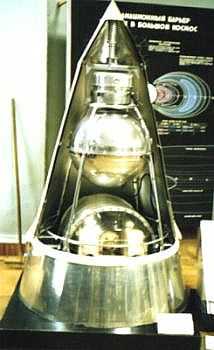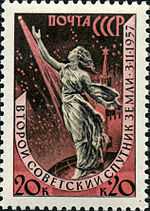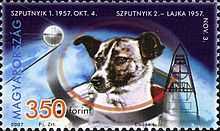Sputnik 2
 Model of Sputnik 2 at the Polytechnic Museum in Moscow | |
| Mission type | Bioscience |
|---|---|
| Operator | OKB-1 |
| Harvard designation | 1957 Beta 1 |
| SATCAT № | 00003 |
| Mission duration | 162 days |
| Orbits completed | ~2,000 |
| Spacecraft properties | |
| Manufacturer | OKB-1 |
| Launch mass | 508.3 kilograms (1,121 lb) (Payload only) |
| Start of mission | |
| Launch date | November 3, 1957, 02:30:00 UTC |
| Rocket | Sputnik 8K71PS |
| Launch site | Baikonur 1/5 |
| End of mission | |
| Decay date | April 14, 1958 |
| Orbital parameters | |
| Reference system | Geocentric |
| Regime | Low Earth |
| Semi-major axis | 7,306 kilometres (4,540 mi) |
| Eccentricity | 0.0990965 |
| Perigee | 211 kilometres (131 mi) |
| Apogee | 1,659 kilometres (1,031 mi) |
| Inclination | 65.3 degrees |
| Period | 103.73 minutes |
| Epoch | 3 November 1957[1] |
Sputnik 2 (Russian pronunciation: [ˈsputʲnʲɪk], Russian: Спутник-2, Satellite 2), or Prosteyshiy Sputnik 2 (PS-2, Russian: Простейший Спутник 2 Elementary Satellite 2)) was the second spacecraft launched into Earth orbit, on November 3, 1957, and the first to carry a living animal, a dog named Laika. Sputnik 2 was a 4-metre (13 foot) high cone-shaped capsule with a base diameter of 2 meters (6.6 feet) that weighed around 500 kg, though it was not designed to separate from the rocket core that brought it to orbit, bringing the total mass in orbit to 7.79 tons.[2] It contained several compartments for radio transmitters, a telemetry system, a programming unit, a regeneration and temperature control system for the cabin, and scientific instruments. A separate sealed cabin contained the dog Laika.
Engineering and biological data were transmitted using the Tral D telemetry system, which would transmit data to Earth for a 15-minute period during each orbit. Two photometers were on board for measuring solar radiation (ultraviolet and x-ray emissions) and cosmic rays. Sputnik 2 did not contain a television camera; TV images of dogs on Korabl-Sputnik 2 are commonly misidentified as Laika.[3]
Mission profile

Sputnik 2, known to Korolev's design bureau as""Prosteyshiy Sputnik-2" means "Simple Satellite 2,"[4] was launched into a 212 × 1660 km (132 × 1031 mi) orbit with a period of 103.7 minutes on a modified ICBM R-7, similar to the one used to launch Sputnik 1. The R-7 was also known by its GURVO designation 8K71[5] as well as the "T-3, and M-104,[6] and Type A.[7] The R-7 modified for the PS-2 satellite launch was designated 8k71PS.[8] Unlike Sputnik 1, Sputnik 2 was not designed to detach from the R-7 sustainer core, since Sputnik 1's core stage had demonstrated an acceptable orbital lifespan. This allowed the core's Tral D telemetry system to be used to transmit data, but would lead to speculation that Sputnik 2 had failed to separate.[9] After reaching orbit interior temperatures rapidly climbed to over 40 °C (100 °F), and Laika survived for only a few hours instead of the planned ten days.[10] The orbit of Sputnik 2 decayed and it re-entered Earth's atmosphere on 14 April 1958 after 162 days in orbit.
| Instruments | |
|---|---|
| Dog Laika: | Biological data |
| Geiger counters : | Charged particles |
| Spectrophotometers: | Solar radiation (ultraviolet and x-ray emissions) and cosmic rays |
Passenger

The first living creature (larger than a microbe) to enter orbit was a female mongrel, originally named Kudryavka (Little Curly) but later renamed Laika ("Barker"). Her true pedigree is unknown, although it is generally accepted that she was part husky or other Nordic breed, and possibly part terrier. NASA refers to Laika as a "part-Samoyed terrier."[11] Laika was selected from ten candidates at the Air Force Institute of Aviation Medicine, because of her even temperament.[12] She weighed about 6 kg (13 lb). The pressurized cabin on Sputnik 2 allowed enough room for her to lie down or stand and was padded. An air regeneration system provided oxygen; food and water were dispensed in a gelatinized form. Laika was chained in place and fitted with a harness, a bag to collect waste, and electrodes to monitor vital signs. Early telemetry indicated Laika was agitated but alive and well, though the cabin temperature had already reached 43 °C (109 °F) by the third orbit. Biometric telemetry failed sometime after the fourth orbit.[13] While it was initially claimed Laika had survived in orbit for a week, decades later Russian sources revealed that Laika likely lived only a few hours in orbit before dying from overheating.[14] The mission provided scientists with the first data on the behavior of a living organism in the space environment.[15]
Sputnik 2 and the Van Allen radiation belt
Sputnik 2 detected the Earth's outer radiation belt in the far northern latitudes, but the significance of the elevated radiation was not realized. In Australia, Professor Harry Messel intercepted the signals but the Soviets would not provide the code and the Australians would not send the data. In 1958, with Sputnik 3, they began to cooperate and confirmed the findings of the U.S. satellites Explorer 1, 3, and 4.
Replicas
A copy of Sputnik 2 that was used in testing before the launch is located at Kansas Cosmosphere and Space Center in Hutchinson, Kansas.[16]
Footnotes
- ↑ McDowell, Jonathan. "Satellite Catalog". Jonathan's Space Page. Retrieved 29 October 2013.
- ↑ "Russian Space Web".
- ↑ "Sputnik-2". 2007.
- ↑ Siddiqi, Asif A.. Sputnik and the Soviet Space Challenge, Gainesville, Florida. The University of Florida Press, 2003, p. 155. ISBN 0-8130-2627-X
- ↑ Zaloga, Stephen J.. The Kremlin's Nuclear Sword, Washington. The Smithsonian Institution Press, 2002, p. 232. ISBN 1-58834-007-4
- ↑ Cox, Donald & Stoiko, Michael, "Spacepower what it means to you," Philadelphia, Pennsylvania, The John C. Winston Company, p. 69, 1958
- ↑ Bilstein, Roger E., "Stages to Saturn a Technological History of the Apollo/Saturn launch Vehicles," Washington D.C., National Aeronautics and Space Administration, p.387. 1980, NASA SP 4206
- ↑ Siddiqi, Asif A.. Sputnik and the Soviet Space Challenge, Gainesville, Florida. The University of Florida Press, 2003, p. 163. ISBN 0-8130-2627-X
- ↑ "Russian Space Web". November 3, 2012.
- ↑ Siddiqi, Asif A.. Sputnik and the Soviet Space Challenge, Gainesville, Florida. The University of Florida Press, 2003, p. 174. ISBN 0-8130-2627-X
- ↑ Sputnik 2. National Space Science Data Center. Accessed April14, 2015.
- ↑ Siddiqi, Asif A.. Sputnik and the Soviet Space Challenge, Gainesville, Florida. The University of Florida Press, 2003, p. 173. ISBN 0-8130-2627-X
- ↑ "Sputnik-2".
- ↑ "Russian Space Web".
- ↑ Chernov, V. N., and V. I. Yakovlev, Scientific research during the flight of an animal in an artificial earth satellite, Artif. Earth Satell., No. 1, 80-94, 1958
- ↑ List of Artifacts; Kansas Cosmosphere and Space Center.
References
- Bilstein, Roger E., "Stages to Saturn a Technological History of the Apollo/Saturn launch Vehicles," Washington D.C., National Aeronautics and Space Administration, NASA SP 4206
- Cox, Donald & Stoiko, Michael, "Spacepower what it means to you," Philadelphia, Pennsylvania, The John C. Winston Company
- Harford, James.. Korolev, New York. John Wiley & Sons, Inc., ISBN 0-471-14853-9.
- Siddiqi, Asif A., Sputnik and the Soviet Space Challenge, Gainesville, FL. The University of Florida Press, ISBN 0-8130-2627-X.
- Swenson, L, Jr, Grimwood, J. M. Alexander, C.C. This New Ocean, A History of Project Mercury, Washington D.C.. National Aeronautics and Space Administration, Library of Congress Card No. 66-62424
- Zaloga, Stephen J.. The Kremlin's Nuclear Sword, Washington. The Smithsonian Institution Press, ISBN 1-58834-007-4.
External links
- Sputnik: 50 Years Ago
- Anatoly Zak on Sputnik-2
- Sputnik 2 Diary
- NSSDC Master Catalog: Spacecraft Sputnik 2
- Sputnik 2 at Astronautix
- Usilaika - More about Laika
| ||||||||||